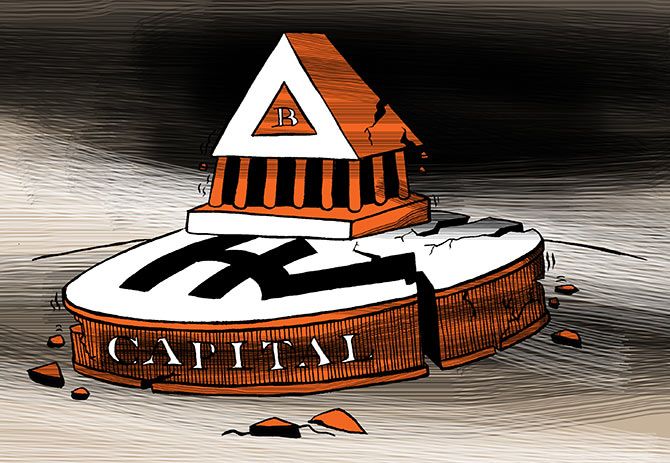Given the relevance of bank deposits for Indian savers, whether the regulator would permit linking savings interest rate to a repo-like structure needs to be seen, as a move of this nature could increase volatility in savings also.
Illustration: Uttam Ghosh/Rediff.com

Stocks of public sector banks (PSBs) were buzzing in Monday’s trade - up between nearly 2 per cent and 8 per cent, thanks to the near-term recapitalisation measure reiterated last Friday by the government.
While the latest government measure should support growth in FY20, the question remains whether growth will come at the cost of profitability if PBSs link their lending rate with the Reserve Bank of India’s (RBI’s) repo rate.
Picking the trend started by State Bank of India (SBI), which recently introduced repo rate-linked loans, the finance minister on Friday nudged other PSBs to adopt this practice.
Repo rate is the rate at which a country’s central bank (like RBI) lends to commercial banks, when necessary.
The central bank typically uses repo rate to control inflation and/or drive growth, as deemed necessary based on the country’s economic situation.
The intent behind the government’s and RBI’s push is to ensure that banks cut their lending rates in tandem with the sharp fall in repo rate, and consequently help drive consumption and investment in the country.
Repo rate has been axed from 6.25 per cent in February to 5.40 per cent in the recently concluded monetary policy. On the other hand, SBI’s Ecowrap report - authored by Soumya Kanti Ghosh, group chief economic adviser, indicates that the average lending rate has reduced by only 20–35 basis points (bps) since January.
Transmission by private banks is far less - 15–20 bps.
So, what’s holding back banks from passing on the lower repo rate to customers?
Lending rates is a function of cost of funds, mainly that of deposits which are considered as the cheapest among all means of capital.
Therefore, unless banks have the bandwidth to reduce their deposit rates, particularly on bulk deposits, faster transmission of the repo rate cut, without hurting their profits, to the ultimate borrower could be tough.
So far, PSBs - which are more bulged on deposits - have been able to reduce their deposit rate by 30–60 bps in two years, while their private peers (barring ICICI Bank) have slashed rates by a lower proportion of 20–50 bps during this period.
While private banks are more focused on garnering low-cost CASA (current account–savings account) deposits, which are also the cheapest source of deposit funds, for PSBs the focus has been on bulk deposits.
Ghosh reasons out that transmission of the repo rate cut is not happening as expected because any bank taking a lead on deposit rate (a function that is market-determined) would probably lose meaningful quantum of business as bulk customers would have better bargaining power or would easily switch banks.
This was true in the case of CASA deposits as well, and the event played out prominently in the June quarter.
Private banks, including HDFC Bank, witnessed a 200–400 bps year-on-year fall in CASA ratio as customers, mainly retail deposit holders, preferred the better-yielding term deposits over CASA.
While the swing from CASA to term deposits wasn’t prominent for PSBs, the industry average was about 33 per cent for the segment.
This has prompted analysts at Motilal Oswal to comment that sluggish deposit growth and stretched balance sheet for private banks have limited banks’ ability to reduce deposit rates.
Also, analysts at CLSA say it will be important to watch if banks can manage moral persuasion in a margin-neutral manner.
“A 5 bps risk to margins can impact FY20 earnings by 4 per cent with higher impact for PSBs,” they observe.
As a solution to better transmission of rate cuts, a certain segment of economists, including Ghosh, advocates for a similar linking of deposit rate to the policy rate, though its implementation would require regulatory will.
Given the relevance of bank deposits for Indian savers, whether the regulator would permit linking savings interest rate to a repo-like structure needs to be seen, as a move of this nature could increase volatility in savings also.











